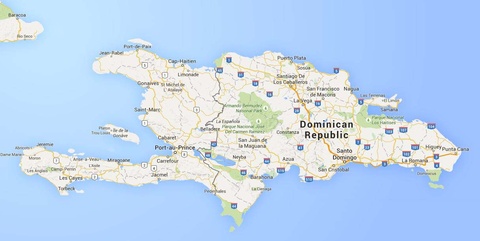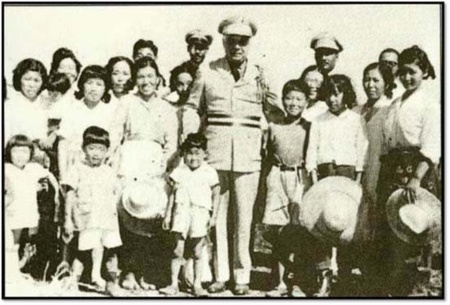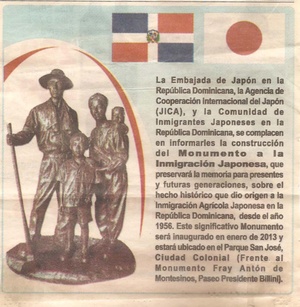Japan’s Ministry of Foreign Affairs estimates that in October 2013 about 800 people of Japanese descendants were Dominican citizens and an additional 873 residents were Japanese citizens. In all 1,673 Nikkei were residing in the Dominican Republic.
A mostly mulatto nation, the Dominican Republic is racially and ethnically a heterogeneous society. Adding to the heterogeneity, between 1956 and 1959 over 1,500 Japanese moved to the Dominican Republic. The presence of Japanese immigrants in the Dominican Republic is unique. According to The 1989 Japan Statistical Yearbook, of all Caribbean nations, the Dominican Republic is the only one in which Japanese immigrants arrived as settlers.
The Japanese presence in the Dominican Republic can be linked to the Dominican Japanese relations that began with trade by the middle of 1930. Gradually, Japan became a good customer of the Dominican Republic by importing sugar in large quantities. Based on those and other exchanges, an agreement between Japan and the government of the dictator Rafael Trujillo, who exercised power from 1930 to 1961, was formalized in 1956 to bring Japanese “To the Paradise of the Caribbean” as the spokespersons of the regime called the country.
I. Dominican and Japanese agreement
Experts and officials of Japan visited the Dominican Republic to evaluate the characteristics and conditions of the places where the colonies would be established. After many discussions and negotiations, the two countries agreed that the Dominican’s government responsibilities were to provide: 1) A furnished house per family; 2) Up to 300 tareas of land per family (One U.S acre is equal, approximately, to six Dominican tareas); 3) Sixty cents per day for each family member (In 1956 a Dominican peso was equal to one U.S dollar); and 4) Government tax exemptions for the items that the immigrants would bring from Japan.
The Japanese government was in charge of: 1) Selection of the immigrants; 2) Transportation costs, including a round trip in case someone wanted to return; and 3) Supervision of the facilities and colonial sites.
The Immigrants duties were: 1) To pay 150 yen for their transportation; 2) To work and cultivate the land; and 3) To respect and to follow the Dominican laws.
The first Japanese immigrants arrived in the Dominican Republic on July 26, 1956, aboard the SS Brazil Marú. Officials of the Dominican Ministry of Agriculture and members of the Japanese diplomatic corps welcomed 28 families, a total of 186 people. After a tour around Ciudad Trujillo, as the capital was called then, the immigrants were transferred to La Vigía, about seven kilometers from the city of Dajabón, where the first settlement of Japanese colonists was established.
Subsequently, other groups arrived. In the end, a total of 249 families (1,320 immigrants) migrated between 1956 and 1960.
| Chronology of the Japanese immigration to the Dominican Republic |
|
| DATE | Number of Immigrants |
| July 1956 | 186 |
| October 1956 | 157 |
| December 1956 | 72 |
| March 1957 | 151 |
| November 1957 | 61 |
| December 1957 | 150 |
| January 1958 | 88 |
| May 1958 | 158 |
| June 1958 | 174 |
| June 1959 | 92 |
| September 1959 | 31 |
| TOTAL | 1,320 |
| Year | 1956 | 1957 | 1958 | 1959 |
| TOTAL | 415 | 362 | 420 | 123 |
| Source: Harvey Gardiner, La política de inmigración del dictador Trujillo, 218-219. The figures are also available from El Caribe, which published the information about the arrival of immigrants on each ship. |
II. Localization of the colonies
As indicated below, six of the eight colonies were established along the border with Haiti. The other two, Jarabacoa and Constanza, were located in the productive land of the Cibao region in La Vega. All the colonies were destined for agricultural production, except Manzanillo which was selected as a fishing venture.
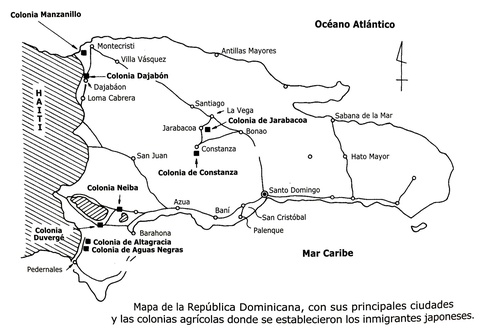
The establishment of six of the settlements along the border with Haiti was part of the Dominican government’s plan to populate the area with nationals and foreigners (Spaniards, Hungarians, and Japanese) in order to prevent infiltrations of Haitians.
III. Agricultural production and fishing project
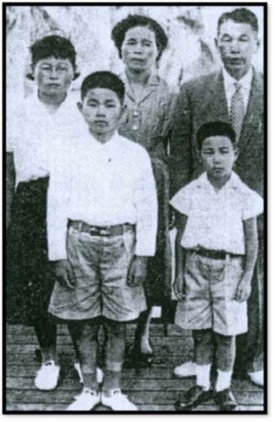
Horticulture, in greater or lesser scale, was the common farming of all Japanese colonies established in the Dominican Republic. Two months after the arrival of pioneers in La Vigía, the Dominican press reported that immigrants had planted a great variety of vegetables, including peanut, rice, corn, and sweet potatoes. In addition, they had also planted fruits and tobacco. Later, the media highlighted also the production of vegetables and flowers in Constanza and Jarabacoa and the achievements of the other colonies.
Impressed by the production of the colony in Dajabon, Dominican government officials and Japanese diplomats visited the immigrants to congratulate them for their efforts. Visitors included Kenkichi Yoshida, Minister of Japan in the Dominican Republic, and Dominican Agriculture Minister Luis Mercado. The rapid progress made by migrants motivated Trujillo’s first visit to the colony, at the end of November 1956. The visit pointed out the success of the colony, which were very evident, but did not mention the difficulties and problems that the immigrants were confronting, among them the lack of water and shortage of land. In the other colonies, mostly those located along the south border with Haiti, the immigrants had a very hard time growing what they planted. Nonetheless, they cultivated tobacco, soya, coffee, and other products.
The immigrants tried also to develop a fishing industry. In October 1956, five families of fishermen were sent to Manzanillo, one of the best ports on the North coast of the island. Two months after their arrival, immigrants had obtained more than five thousand pounds of fish. Two years later, the newspaper El Caribe (February 28, 1958) reported that the fishermen were “encouraging a flourishing fishing industry” and were supplying fish and seafood to the Cibao region.
IV. Problems
Despite early success, all of them experienced a variety of problems that limited or impeded production. Some complications were serious:
- The majority of the settlements were established in farming areas with poor soil and a shortage of water.
- Roads that linked the colonies to the nearby communities and to outside markets were in very poor condition.
- The size of the land promised was less than the land that immigrants received.
- The fishing project failed to achieve the goals because of a number of difficulties. There were: 1) a lack of market and a lack of electricity; 2) the boats that brought the immigrants were not suited for fishing in open waters of the Atlantic Ocean; and 3) the supply of fish was not renewable. One could fish only once in an area.
The problems intensified after the death of Trujillo in 1961. During the period of transition from dictatorship to democracy, political instability, and social insecurity created a chaotic situation that altered the way of life. In the midst of turbulence, Dominicans showed resentment against the economic progress of some Japanese. This situation, in conjunction with a lack of support on the part of the Japanese government, led to demand for repatriation or relocation in other Latin American settlements. By 1962, 672 of the Japanese had been sent back to Japan, and 377 relocated in South America.
V. Legal demands and claims
Adding a new feature to the presence of Japanese in the Dominican Republic, the immigrants filed a lawsuit against the Japanese government for encouraging the emigration of its citizens to a country that had no capacity to satisfy the goals of the immigrants. This initiative is considered as the first time that emigrants from Japan have taken their government to court for failing to provide an adequate resettlement.
After a series of litigations and individual and collective claims, in 1985 the immigrants began a legal process, claiming compensation for damages and suffering. They also demanded a pension and health insurance. Their lawyers presented their case to the Japanese Court of Justice on July 18, 2000. In 2006, the court issued a ruling that acknowledged the government’s responsibility. However, the court rejected the request for compensation, saying that the plaintiffs had already lost their right to request compensation as more than 20 years had passed since the immigration started. Later, although not all the immigrants approved the procedures, both sides reached a settlement.
VI. Innovations
In spite of the difficulties, the Japanese presence and initiatives in the Dominican Republic have produced changes that have transformed Dominican society and added diversity to the national culture. The immigrants brought with them a more advanced approach to agriculture, including the use of fertilizers and insecticides, and innovative technology and machinery. One important novelty was the development of a new variety of rice, called Tanioka in honor of Yoshichi Tanioka, who developed the technique to produce hybrid plants that were more appropriate for the climatic conditions of the country.
The Japanese introduced also previously unknown food and, to some extent, one can say that they caused a revolution in the Dominican diet. For example, the elegant celery, which because of its scarcity and high price was seen as a food for the rich. After the arrival of the Japanese immigrants, the vegetable has become a component of Dominican cuisine.
In fishing, two novelties were the use of electric machines to produce fishmeal and a tricycle to transport the products. Another innovation was the introduction of fishing nets fitted with special fluorescent lights to attract fish during the night. This technique has become a common practice used by Dominicans. According to Guillermo Sanchez, an agronomist (interviewed by the author in July 2000), one of the legacies of greater significance of Japanese fishermen to the Dominican community was the development of aquaculture, a system that involves the rearing of fish and shellfish in closed areas or ponds.
In addition, the immigrants contributed to improve the means of transportation by using motorcycles to go from the colonies to the market and other places. Gradually, Dominicans imitated the Japanese and added a new dimension by using such vehicles to transport passengers around the country. The enterprise is known as motoconcho.
VII. Interaction and acculturation
At first glance, when comparing Japan with the Dominican Republic, one sees that the two nations appear to be far away from each other—not only geographically—and a common bond between them is difficult to perceive. In addition to the difference between Western and the Eastern cultures, the economic distance is also clear: Japan is a country developed and industrialized; the Dominican Republic is agricultural and undeveloped. However despite the contrast, one must notice that there are also similarities between the two nations. Among other things, the Japanese and the Dominicans share the tradition of eating rice every day and enjoy playing baseball. Based on these and other common denominators, both groups have developed strong bonds of friendship and cooperation. Intermarriages had also generated the formation of new families, the Nikkei Dominican-Japanese or Japanese-Dominican.
Established in different parts of the country, either as students or instructors, the presence of the immigrants is well-known in different schools: primary, secondary, as well as in higher education. This presence on school campuses is an indication that the Japanese community lives and works together with the Dominicans. Another indication of the interaction between the two groups is that Dominicans have assimilated agricultural techniques, fishing, gardening, and sport practices, such as judo and karate, and religious beliefs, including Buddhism and Soka Gakkai. At the same time the Japanese have incorporated patterns of Dominican lifestyle to their Modus Vivendi that include language, food, and fun.

VIII. Conclusion
In 2015, the Japanese are exercising a variety of work and professions in all sectors of the Dominican society. Members of the Japanese community are working in a variety of independent enterprises. Many have distinguished themselves in the international trade of fruits, vegetables, and flowers. Others are recognized for their high quality work in the automobile repairing service or they are automobile dealers. The Japanese community lives and works side by side with the Dominicans, and the Dominicans have assimilated some Japanese farming and fishing skills. Certainly, the majority of immigrants left because of the frustrations, but many of those who stayed made economic progress.
Finally, I was invited to make a presentation at the convention of COPANI 2015, celebrated in Santo Domingo, from August 7 to 9, 2015. I decided to learn a little more about the background of the term Nikkei. Among other things, I learned that the definition and application of the word derived from a study called International Nikkei Research Project, which led to three years of study, with participation from more than 100 researchers, from 14 institutions that, in some ways, gave their support to the project. This data reinforced my desire to work on the second edition of the text on the Japanese immigration to the Dominican Republic, which I hope will be published, in 2016, in commemoration of the 60th anniversary of the arrival of the Japanese immigrants to the Dominican Republic.
References:
1. Comité de la Asociación Dominico-japonesa. Pioneros en una isla del Caribe: Historia del XXV aniversario. Tokyo: Kodansha Publication, 1991.
2. Comité Ejecutivo de la Conmemoración del Cincuentenario de la Inmigración de Japoneses al País Dominicano. El Paraíso del Caribe: Medio siglo de Alegría y Tristeza. Hoy día todavía nos encontramos vivos aquí. La Vega: Impresora Universal, 2006.
3. Despradel, Alberto. La migración japonesa hacia la República Dominicana. Santo Domingo: Editora de Colores, 1996.
4. Gardiner, C. Harvey. La política de inmigración del dictador Trujillo. Estudio de la creación de una imagen humanitaria. Santo Domingo: Universidad Nacional Pedro Henríquez Ureña, 1979.
5. Horst, Oscar y Katsuhiro Asagiri. “The Odyssey of Japanese Colonists in the Dominican Republic,” The Geographical Review, 90, 3 (July 2000): 335-358
6. “Japón pide perdón a los nipones que emigraron a RD en los 50”. Diario Libre, 22 de julio de 2006.
7. Masterson, Daniel M. and Sayaka Funada-Classen. The Japanese in Latin America. Urbana: University of Illinois Press, 2004.
8. Peguero, Valentina. Colonización y política: los japoneses y otros inmigrantes en la República Dominicana. Banco de Reservas. Santo Domingo: Alfa y Omega, 2005.
9. -----Immigration and Politics in the Caribbean: Japanese and Other Immigrants in the Dominican Republic. Coconut Creek, Fla.: Caribbean Studies Press, 2008.
10. Rippy, J. Fred. “The Japanese in Latin America,” Inter-American Economic Affairs 3:1 (Summer 1949): 50-65.
© 2015 Valentina Peguero


